To make a cough syrup from horehound steep whole horehound in a pot of water, let half of the water evaporate off, then add an equal amount of honey. You can store this in a bottle or jar and use whenever you need an effective cough remedy and expectorant. Other useful herbs to add to this cough syrup are Yerba Santa, Licorice, Anise, Loquat leaves, and marshmallow.
Mission Statement
My goal with mande plants is to teach about medicinal and edible plants, show how to grow these plants, where to find these plants, and how to use these plants. There are many useful botanicals in our world. I will growing seasonal crops and perennial edibles using organic methods as best as possible. One of my long term goals is to grow a temperate food forest garden. As I grow new plants and harvest them I will be sharing photos and details on this blog. All photos on this blog are taken by me. If you like this blog and you would like to help me further my research you can use the paypal donate button on the right. All donations will be used to buy tools, plants, seeds, and pay for expenses needed to develop gardens.
Tuesday, November 30, 2010
Horehound - Marrubium vulgare
Horehound is a bitter tasting herb of the Mint family, and like other plants in this family it has some great medicinal uses. This herb is can be used to soothe the throat, expel excess mucous (expectorant) and restore appetite. Horehound can be made into a tea or a cough syrup.
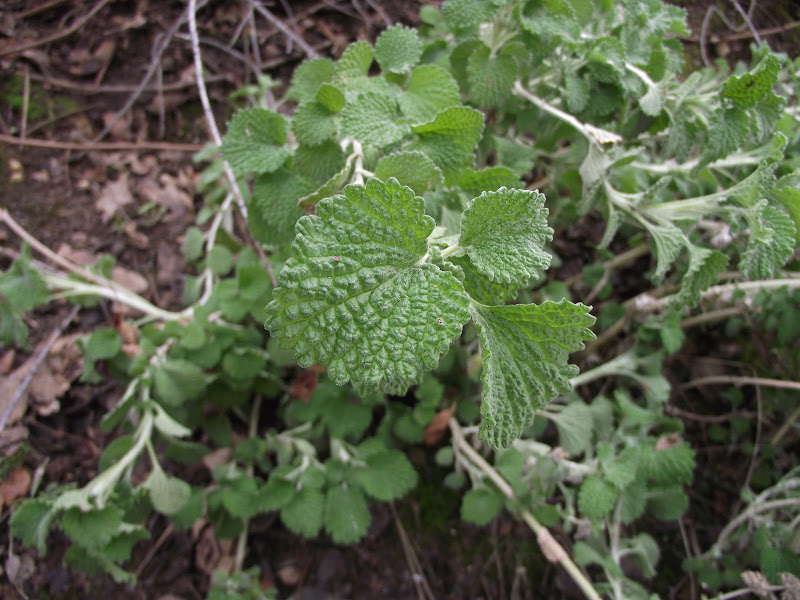
To make a cough syrup from horehound steep whole horehound in a pot of water, let half of the water evaporate off, then add an equal amount of honey. You can store this in a bottle or jar and use whenever you need an effective cough remedy and expectorant. Other useful herbs to add to this cough syrup are Yerba Santa, Licorice, Anise, Loquat leaves, and marshmallow.
To make a cough syrup from horehound steep whole horehound in a pot of water, let half of the water evaporate off, then add an equal amount of honey. You can store this in a bottle or jar and use whenever you need an effective cough remedy and expectorant. Other useful herbs to add to this cough syrup are Yerba Santa, Licorice, Anise, Loquat leaves, and marshmallow.
Monday, November 29, 2010
subscibing to my blog on phones
Some phones have the option to subscribe to a custom news feed. If you put http://mandeplants.blogspot.com in the address box you can subscribe to my blog.
Friday, November 12, 2010
Yerba Santa - Eriodictyon californicum
Yerba Santa is an herb found growing in California and Oregon. This plant has both medicinal and edible qualities to it. Medicinally Yerba Santa has been used to treat Asthma, cough, and hay fever. The herb is also an expectorant, which helps discharge phlegm and other fluids from the respiratory tract.

Yerba Santa Leaves
The leaves of Yerba Santa have a resinous texture to them. When chewed waves of bitterness and sweetness can be experienced on the tongue.

Yerba Santa Flowers
Yerba Santa Leaves
The leaves of Yerba Santa have a resinous texture to them. When chewed waves of bitterness and sweetness can be experienced on the tongue.
Yerba Santa Flowers
Thursday, November 11, 2010
California Bay Laurel nuts - Umbellularia californica
California Bay Laurel or Umbellularia californica is found in the coastal hill and foothills of California and southern Oregon. This tree is in the same family as Avocado, Bay, and Cinnamon, which is quite evident of the way the fruits look and the leaves smell.

California Bay Laurel Fruit
After picking the fruit and placing them in a colander I took off the fatty fruit pulp.

California Bay Laurel Fruit and seed
Once all of the nuts were de-fruited I put them in a pyrex dish.
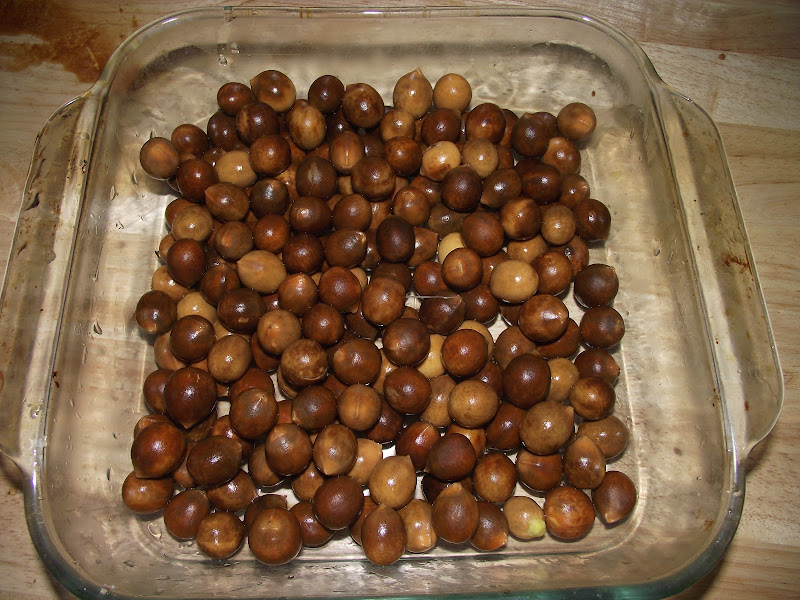
California bay laurel nuts or seeds
I roasted the nuts in the oven at 350 degrees until the kernals became a dark chocolate brown.

Roasted California Bay Laurel Nuts
When my wife and I tried the Bay Nuts she described the flavor quite well, "it taste like slightly burnt popcorn". In my opinion the texture is like that of peanuts, with a dark bitter flavor. Others have also described the taste as having a coffee or cocoa like flavor.
These nuts also make a very tastey beverage. I tried the drink plan and with sugar and cream. The plain drink has a spicy nutty flavor. The sugar and cream I added complemented the beverage very well, it reminded me of coffee with hazelnut creamer.
California Bay Laurel Fruit
After picking the fruit and placing them in a colander I took off the fatty fruit pulp.
California Bay Laurel Fruit and seed
Once all of the nuts were de-fruited I put them in a pyrex dish.
California bay laurel nuts or seeds
I roasted the nuts in the oven at 350 degrees until the kernals became a dark chocolate brown.
Roasted California Bay Laurel Nuts
When my wife and I tried the Bay Nuts she described the flavor quite well, "it taste like slightly burnt popcorn". In my opinion the texture is like that of peanuts, with a dark bitter flavor. Others have also described the taste as having a coffee or cocoa like flavor.
These nuts also make a very tastey beverage. I tried the drink plan and with sugar and cream. The plain drink has a spicy nutty flavor. The sugar and cream I added complemented the beverage very well, it reminded me of coffee with hazelnut creamer.
Tuesday, November 9, 2010
Landscape Plants - Society Garlic - Tulbaghia alliacea
Society Garlic is not a true garlic as it is not in the allium genus, but they are both in the same family. The botanical name is Tulbaghia violacea. This plant hails from South Africa where the native would use this plant for its culinary uses. The Corm or bulb, the leaves, and the flowers are all edible. Eating the leaves raw will render a very distinctive garlic taste in the mouth. The flower can be added to salads for both their edible value and their visual appeal. The bulb can be used like garlic would, and the leaves may be used like spring onion or chives would be used.
Monday, November 8, 2010
Pineapple weed - Matricaria matricarioides

Pineapple weed is a commonly found plant that grows in disturbed soil. The flavor, aroma, and medicinal uses are the same as chamomile. When harvesting this plant make sure it isn't grown where herbicides are used. It is also a smart idea to make sure there are no feces around the plant. While the whole plant may be used to make a tea, the flowering tops are where the flavor is. The Flowering tops may be eaten raw, they have a sweet chamomile like taste. The plant is antispasmodic, carminative, and sedative.
Thursday, November 4, 2010
Fruits of the Mountains part 2
Continuing on from part 1 I will post info on more fruits found in the Sierra Nevada.
Arctostaphylos - Manzanita

The tart sticky berries of this may be eaten fresh, cooked, or made into a cider like beverage. When eating these berries fresh some caution is advised as excess quantities of raw fruit can tax the digestive system. To make a spicy tart cider from these berries as equal measurements of berries and water in a pot and cook until the berries become soft and tender. Mash the fruit up, turn off the heat, cover the pot and let sit for a couple of hours. After the time has passed you can come back, strain the pulp and drink the refreshing drink. On a side note, sugar may be added if you like your drinks sweet.
Rubus armeniacus - Himalayan Blackberry
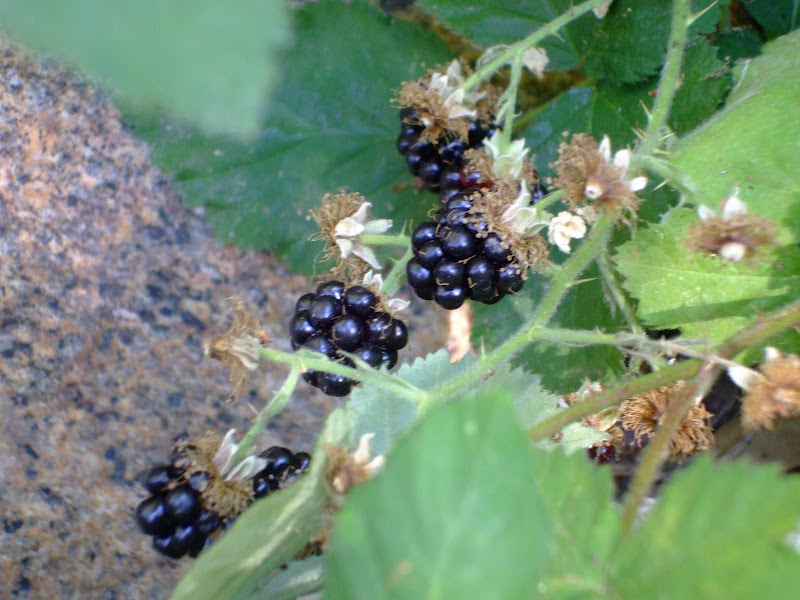
Most of us have had blackberries at some point in our life. The Rubus genus is found in North America, Europe, Asia, and Australia. The Berries I have photographed are not native to the Sierra Nevada but quite invasive.
Cornus sericea - Redosier Dogwood

These berries are not noteworthy as far as taste is concerned. They have been reported to be edible and are best when made into a pemmican or preserve with other berries. These trees can be found growing near streams.
Solanum americanum - American Nightshade

American Nightshade belongs to a genus and family that is notorious for having toxic alkaloids, so extreme caution is advised. The young leaves and fully ripe fruit are edible when cooked thoroughly. On a side note, both Eggplant and Potato are in the Solanum genus as well.
Aesculus californica - California Buckeye
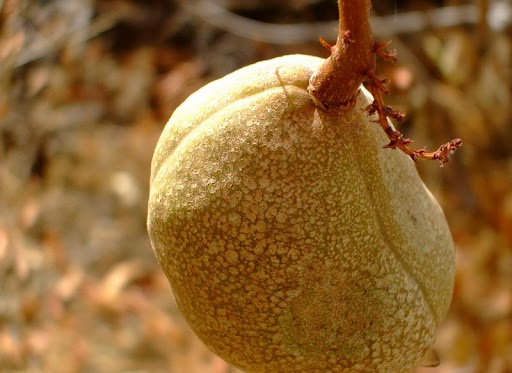
California Buckeye seeds were eaten by California Indian tribes when acorns were not as abundant. The seeds are high in saponins so they must be properly prepared before being consumed. The natives would slow roast the seeds and follow this by leaching them in running water. After this they could make an edible flour with a fair amount of protein and carbohydrates.
Arctostaphylos - Manzanita
The tart sticky berries of this may be eaten fresh, cooked, or made into a cider like beverage. When eating these berries fresh some caution is advised as excess quantities of raw fruit can tax the digestive system. To make a spicy tart cider from these berries as equal measurements of berries and water in a pot and cook until the berries become soft and tender. Mash the fruit up, turn off the heat, cover the pot and let sit for a couple of hours. After the time has passed you can come back, strain the pulp and drink the refreshing drink. On a side note, sugar may be added if you like your drinks sweet.
Rubus armeniacus - Himalayan Blackberry

Most of us have had blackberries at some point in our life. The Rubus genus is found in North America, Europe, Asia, and Australia. The Berries I have photographed are not native to the Sierra Nevada but quite invasive.
Cornus sericea - Redosier Dogwood
These berries are not noteworthy as far as taste is concerned. They have been reported to be edible and are best when made into a pemmican or preserve with other berries. These trees can be found growing near streams.
Solanum americanum - American Nightshade
American Nightshade belongs to a genus and family that is notorious for having toxic alkaloids, so extreme caution is advised. The young leaves and fully ripe fruit are edible when cooked thoroughly. On a side note, both Eggplant and Potato are in the Solanum genus as well.
Aesculus californica - California Buckeye

California Buckeye seeds were eaten by California Indian tribes when acorns were not as abundant. The seeds are high in saponins so they must be properly prepared before being consumed. The natives would slow roast the seeds and follow this by leaching them in running water. After this they could make an edible flour with a fair amount of protein and carbohydrates.
Landscape Plants - Pyracantha or Firethorn
Pyracantha belongs to the Rose family and like other plants in this family it has hydrogen cyanide present in its seeds and fruit. Because of the presence of Hydrogen Cyanide you would not want to eat these fruits raw in excess. While Hydrogen Cyanide is a respiratory and digestive stimulate in small quantities it can be quite toxic if too much is consumed. Cooking them on the other hand renders the toxin harmless. Firethorn makes excellent sauces and preserves when cooked with sugar or honey.
Wednesday, November 3, 2010
Fruits of the Mountains part 1
The Sierra Nevada mountain range has plenty of edible fruit as well as not so edible. Some fruit may be completely edible, some edible when cooked, and others not edible at all. In this post I will give a brief overview on some of the Fruits of the Mountains.
Prunus emarginata - Bitter Cherry
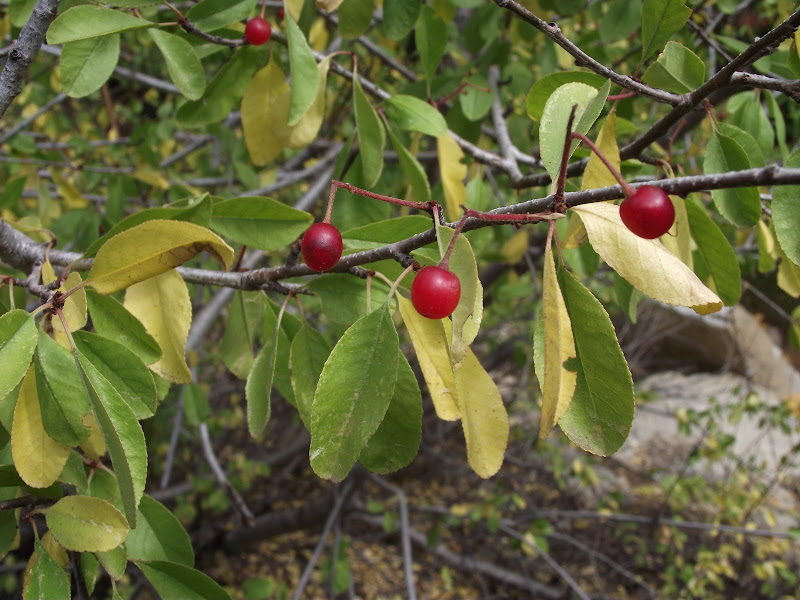
Bitter Cherry is high in Hydrogen Cyanide, which is toxic. Hydrogen Cyanide is volatile and destroyed by heat when cooked. This is a fruit you would not want to eat raw.
Streptopus amplexifolius - Twisted Stalk

Twisted Stalk berries are edible but have a slight laxative effect. The Berries have a cucumber like flavor.
Lonicera involucrata - Twin Berry
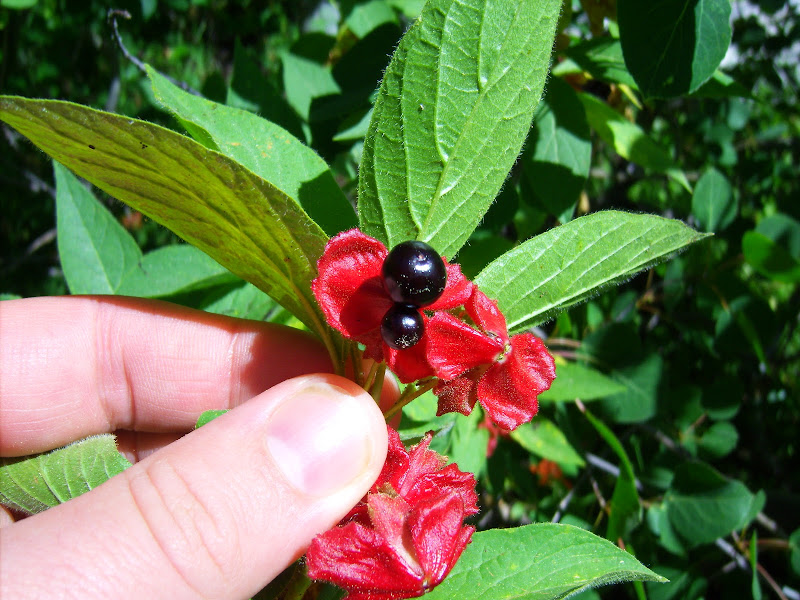
An Edible Berry from the Honey Suckle Family
Marah horridus - Wild Cucumber

While in the same family as the cucumber its not a true wild form of the domesticated cucumber. When cut in half the inside does resemble and smell like a cucumber. The flavor is that of cucumber with a bitter overtone. This fruit is very laxative. I do not recommend eating of this fruit as I have not been able to confirm if this is edible.
Rhamnus rubra - Sierra Coffeeberry
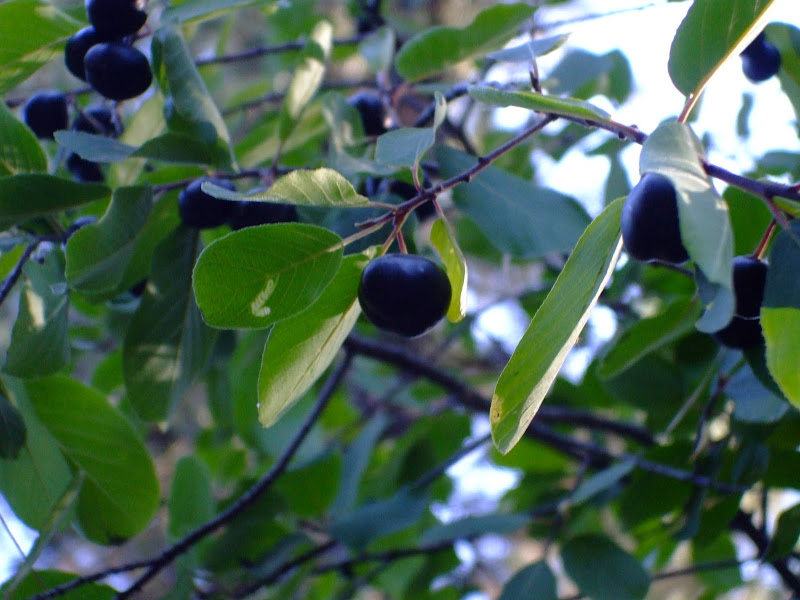
Sierra Coffeeberry is in the Buckthorn family and is not related to Coffee (Coffea spp.). The Berry has laxative propertied and is not recommended as edible.
Cornus nuttallii - Dogwood
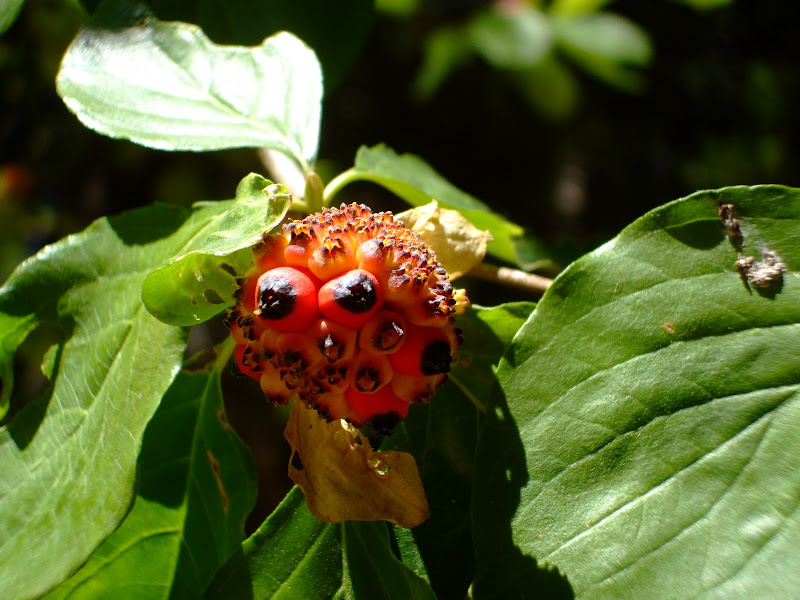
Dogwood fruits are edible. The flavor is mild and not really noteworthy in my opinion. Dogwoods are found in shaded area growing under larger trees.
Ribes roezlii - Sierra Gooseberry
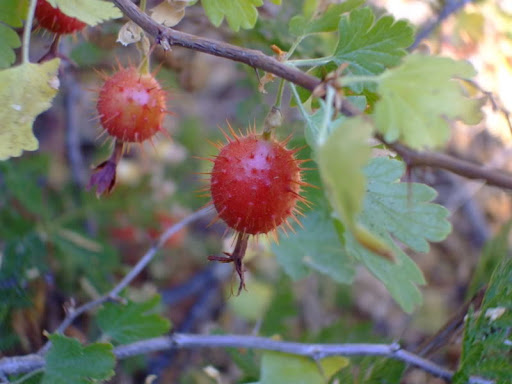
The Sierra Gooseberry has a lot of flavor and pulp for a wild berry. Because their are thorns on the outside of the fruit they can be a little tedious to pick and eat. If one cuts the fruit in half they can scoop out the pulp to enjoy.
Prunus emarginata - Bitter Cherry
Bitter Cherry is high in Hydrogen Cyanide, which is toxic. Hydrogen Cyanide is volatile and destroyed by heat when cooked. This is a fruit you would not want to eat raw.
Streptopus amplexifolius - Twisted Stalk
Twisted Stalk berries are edible but have a slight laxative effect. The Berries have a cucumber like flavor.
Lonicera involucrata - Twin Berry
An Edible Berry from the Honey Suckle Family
Marah horridus - Wild Cucumber
While in the same family as the cucumber its not a true wild form of the domesticated cucumber. When cut in half the inside does resemble and smell like a cucumber. The flavor is that of cucumber with a bitter overtone. This fruit is very laxative. I do not recommend eating of this fruit as I have not been able to confirm if this is edible.
Rhamnus rubra - Sierra Coffeeberry

Sierra Coffeeberry is in the Buckthorn family and is not related to Coffee (Coffea spp.). The Berry has laxative propertied and is not recommended as edible.
Cornus nuttallii - Dogwood

Dogwood fruits are edible. The flavor is mild and not really noteworthy in my opinion. Dogwoods are found in shaded area growing under larger trees.
Ribes roezlii - Sierra Gooseberry

The Sierra Gooseberry has a lot of flavor and pulp for a wild berry. Because their are thorns on the outside of the fruit they can be a little tedious to pick and eat. If one cuts the fruit in half they can scoop out the pulp to enjoy.
Tuesday, July 13, 2010
Common Edible "weeds" - Part 2
The next two edible "weeds" I will be discussing are Chickweed and Clover. While this is mainly about their edible uses I will cover their traditional herbal uses as well.
Chickweed is in the Stellaria Genus, in the Carnation or Caryophyllaceae family. Chickweed can be found growing all year round but is more prevalent in the rainy months. The young tender leaves have the best flavor but mature leaves may be eaten as well. Consumed in excess chickweed may cause diarrhea or vomiting because of its saponin content. Saponins are not easily absorbed by the human body, in moderate amounts chickweed is fine to eat. Chickweed makes a fine addition to pestos and salads. Used externally as a poultice chickweed can help soothe skin inflammations and promote healing.
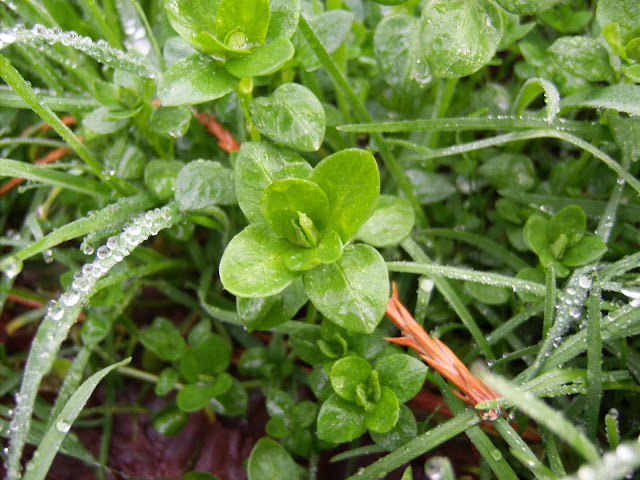
Clover is of the Trifolium genus in the Pea or Fabaceae family. The leaves and Flowers are edible raw or cooked. It is said that the leaves are hard to digest raw and are best cooked. The Flowers and leaves also make a refreshing beverage when steeped in hot water. Sprouted Clover is also a nice addition to salads and sandwiches. Taken internally Clover is good at cleansing the blood, helping to relieve skin conditions like psoriasis and eczema, and has been shown to have some anti-cancer properties.
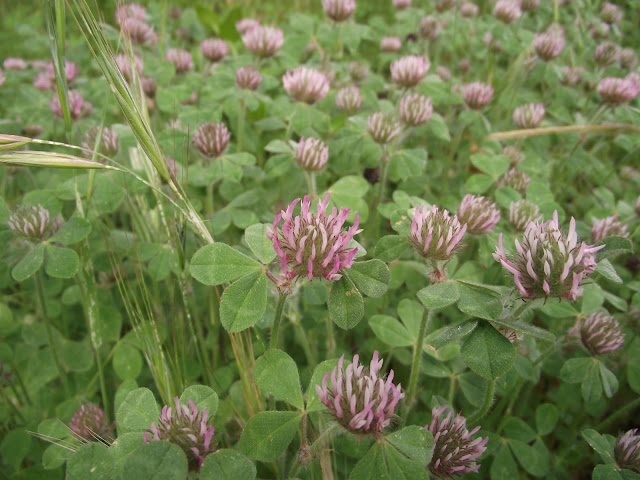
Chickweed is in the Stellaria Genus, in the Carnation or Caryophyllaceae family. Chickweed can be found growing all year round but is more prevalent in the rainy months. The young tender leaves have the best flavor but mature leaves may be eaten as well. Consumed in excess chickweed may cause diarrhea or vomiting because of its saponin content. Saponins are not easily absorbed by the human body, in moderate amounts chickweed is fine to eat. Chickweed makes a fine addition to pestos and salads. Used externally as a poultice chickweed can help soothe skin inflammations and promote healing.
Clover is of the Trifolium genus in the Pea or Fabaceae family. The leaves and Flowers are edible raw or cooked. It is said that the leaves are hard to digest raw and are best cooked. The Flowers and leaves also make a refreshing beverage when steeped in hot water. Sprouted Clover is also a nice addition to salads and sandwiches. Taken internally Clover is good at cleansing the blood, helping to relieve skin conditions like psoriasis and eczema, and has been shown to have some anti-cancer properties.
Friday, July 9, 2010
Common Edible "Weeds" - Part 1
No organic garden or lawn is free of what is commonly called a weed. Much time and aggravation is put into eradicating these innocent little plants. But instead of putting for all the effort to annihilate these herbs why not treat them as another garden crop? The First two plant I will talk about are Dandelion and Plantain.
Dandelion is an amazing food herb. Every part of this plant is edible: the flowers, leaves, roots, and stem. The Flowers may be dipped in batter and fried up as fritters. The leaves being slightly bitter are a refreshing addition to salads. The roots may be eaten raw or cooked and have a bitter turnip like flavor. The root and leaves help to increase and move the flow of bile in body. This plant is also a diuretic, but unlike most diuretics dandelion is high in potassium which is a mineral that is depleted easily via urine. The root is good for the liver as well. Dandelions are high in vitamins A, C, E, B-complex, and iron.

Plantain is in the Plantago genus (not to be confused with the banana plantain). Plantain's leaves are best eaten when young, as they age they become more fibrous. Older plantain leaves are still edible but need to be cooked as a potherb to be enjoyable. The seeds of plantain may be consumed as well. Plantain is high is vitamins A, C, and K.
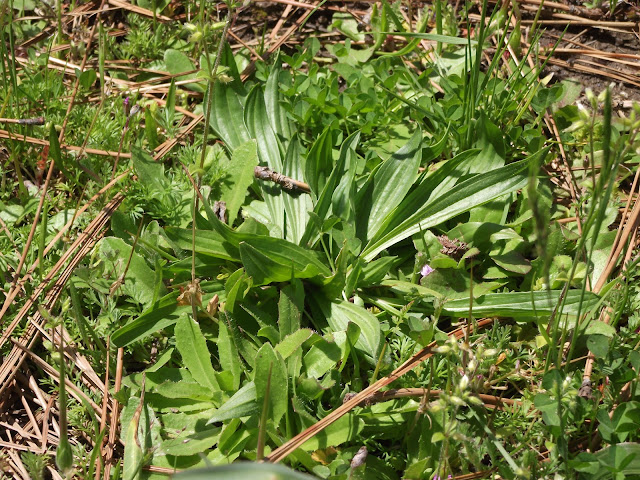
Dandelion is an amazing food herb. Every part of this plant is edible: the flowers, leaves, roots, and stem. The Flowers may be dipped in batter and fried up as fritters. The leaves being slightly bitter are a refreshing addition to salads. The roots may be eaten raw or cooked and have a bitter turnip like flavor. The root and leaves help to increase and move the flow of bile in body. This plant is also a diuretic, but unlike most diuretics dandelion is high in potassium which is a mineral that is depleted easily via urine. The root is good for the liver as well. Dandelions are high in vitamins A, C, E, B-complex, and iron.
Plantain is in the Plantago genus (not to be confused with the banana plantain). Plantain's leaves are best eaten when young, as they age they become more fibrous. Older plantain leaves are still edible but need to be cooked as a potherb to be enjoyable. The seeds of plantain may be consumed as well. Plantain is high is vitamins A, C, and K.
What is Wild Ginger?
The plant commonly referred to as Wild Ginger belongs to the Asarum genus in the Birthwort or Aristolochiaceae family. The Ginger you buy in stores is in the Zingiber genus in the Ginger or Zingiberaceae family. Wild Ginger gets its name from the smell and flavor of its roots and leaves, a ginger/pepper odor and favor. The specific Wild Ginger I will talk about and have photographed is Asarum Caudatum, which is native from British Columbia to California.

Caution is advised when using any plant in this genus, as some have been reported to have some level of toxicity. The roots of this plant may be used as a ginger substitute. They can be harvested all year round but are best harvested in the autumn. The Leaves may be used as well but they do have a stronger flavor and should be used in small quantities.
The root has some laxative properties. It may also be used to help improve digestion, appetite, and as a general tonic to the stomach. The whole plant has analgesic properties as well, which help to relieve pain.
As with all plants, respect must be given to this plant when harvesting. Because the root is what is mainly harvested the plants life is whats taken. Remember to harvested only what is needed not exceeding a third of the plants that grow in the immediate area.
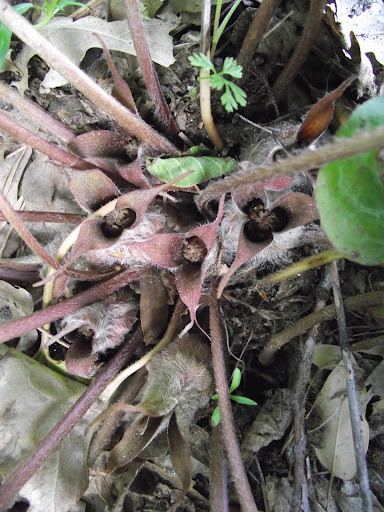
Caution is advised when using any plant in this genus, as some have been reported to have some level of toxicity. The roots of this plant may be used as a ginger substitute. They can be harvested all year round but are best harvested in the autumn. The Leaves may be used as well but they do have a stronger flavor and should be used in small quantities.
The root has some laxative properties. It may also be used to help improve digestion, appetite, and as a general tonic to the stomach. The whole plant has analgesic properties as well, which help to relieve pain.
As with all plants, respect must be given to this plant when harvesting. Because the root is what is mainly harvested the plants life is whats taken. Remember to harvested only what is needed not exceeding a third of the plants that grow in the immediate area.
Thursday, July 8, 2010
First Blog
This is my first blog post. What do I hope to accomplish? I hope that I can condense and display my research in a way that can benefit readers. I will display photo's of plants I have taken and what uses that plants has. I will do my best to include sources of what I have blogged. I hope that whomever reads this will find it beneficial.
Thank you!
Thank you!
Subscribe to:
Posts (Atom)